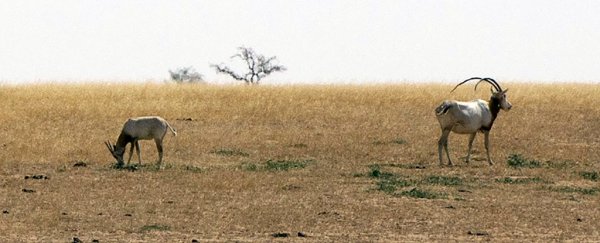Animals that veer close to extinction don't always get a second chance, but scimitar-horned oryx antelopes are now being reintroduced to the Saharan wilderness after disappearing two decades ago.
After being bred for years in captivity, these desert antelopes are ready to step back into the wild: 23 of the animals were released into a remote area of Chad in north-central Africa last August, and another 23 will join them this week.
For the conservationists who helped keep the species alive – working across the United Arab Emirates, the US, Europe, and Australia – it's the start of what could be a remarkable success story.
"So far, the animals look exceptionally healthy," one of the team, Jared Stabach from the Smithsonian's National Zoo and Conservation Biology Institute, told Alice Klein at New Scientist.
"They seem to be adapting to the environment really well."
What makes the comeback even sweeter is that the oryx are being reintroduced into their old stomping grounds, part of the Ouadi-Rimé Ouadi-Achim reserve – the same place that hunters drove them out of in the late 1990s.
 Smithsonian's National Zoo and Conservation Biology Institute
Smithsonian's National Zoo and Conservation Biology Institute
In September, the first calf was born in the wild since the species was officially categorised as extinct in 2008.
"He seems very lively and healthy, so that's encouraging," Stabach told New Scientist.
Even more encouraging is the fact that a number of antelopes have become pregnant after leaving captivity, and are expected to give birth in the coming months.
Conservationists are watching the antelopes very closely while they take their first steps back out into the wild, and GPS collars have been fitted to the animals so they can be tracked and monitored.
Researchers on the ground will be looking to see how far the oryx travel, and whether they stay together or disperse into separate groups. They'll also be able to tell if a poacher tries to interfere with the herd.
Thanks to accelerometers in the collars – similar to the accelerometers that measure movement in our mobile phones – scientists can even get clues about the animals' eating habits, and how they're managing to avoid predators.
The collars can be released remotely and then collected, so the antelopes aren't stuck with them forever.
According to Stabach, the dry season between October and July is the real test for the antelopes, so if they can make it through to August, that really will be something to celebrate.
The scimitar-horned oryx remains on the Red List of threatened species put together by the International Union for Conservation of Nature (IUCN). Habitat loss and overhunting caused them to become extinct in the wild, with their meat and thick hide and prized by locals.
Let's hope the dozens of antelope now roaming wild in the plains of the the Ouadi-Rimé Ouadi-Achim reserve represent the start of a comeback for these beautiful creatures.
One thing that will help the animals' prospects is that lions and cheetahs – their natural predators – are no longer in the same area. Human hunters haven't been a problem so far, either, due to local support for getting the animals reintroduced.
"Conservation scientists are all giving big thumbs up and cheering over this," endangered species specialist Carolyn Hogg, from the University of Sydney in Australia, told New Scientist.
"Animals are often bred in captivity in zoos with the view of releasing them back into the wild, but then there are always lots of challenges. It's pretty amazing to know that you can put them back."
You can keep up with the progress of the antelopes on the Sahara Conservation Fund Facebook Page.
